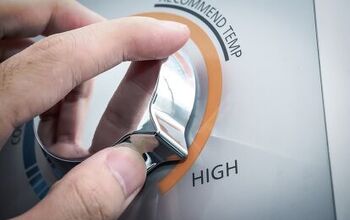Plug Gets Hot When Plugged In? (Possible Causes & Fixes)

An electrical outlet (also referred to as an electrical receptacle) is the place where you plug in all your appliances and electrical devices. When functioning correctly, these will stay at room temperature.
If your electrical plug gets hot while it’s plugged in this can be due to faulty wiring. The best thing to do is to turn off the outlet at the breaker, unplug all appliances and call a professional to come and fix the problem before you use the outlet again.
There are some devices that use an internal transformer to change the voltage input. Typically used by cell phone chargers, computer chargers, cordless drills, and printers, they can cause an outlet to become warm, but never hot. If you notice that your device has an internal transformer and is warm to the touch, unplug it until it cools down.
Do You Need to Hire an Electrician?
Get free, zero-commitment quotes from pro contractors near you.

How an Outlet Overheats
An outlet gets its power from the circuit breaker in your home. When you plug in an appliance, power passes through the plug our outlet to reach it. If the plug or outlet is loose, the electrical current will have to pass through an area with high electrical resistance.
Most of this increased power will be converted to waste heat, which causes the plug to become hot to the touch. The other way that a plug can become hot is through internal electrical faults within the appliance, like a short circuit or if it is improperly grounded.
Video: Melted Plugs and Outlets
Overloaded Circuit
There are times when what you plug into an outlet needs more power than the circuit can safely supply. If you overload a circuit, then it is trying to draw more power than is safe and this excess of energy will heat the outlet.
If you have multiple appliances plugged into outlets that are on the same series, then you could be overloading the circuit. A circuit breaker is designed to trip in this situation but if it doesn’t, it will cause the outlet to heat up.
To deal with this, check what the energy draw is from the appliances you have plugged in. Then check the Amps of that circuit. If they are drawing too much power, relocate them to an outlet that is on a different circuit.
You should not pull any more than 80% of a circuit’s availability. This extra 20% is reserved for power surges, such that happen when an appliance starts up. If you are drawing too much power from a circuit, then a functioning one will trip, cutting the connection until you reset it.
If your circuit is not tripping, this is a major cause for concern. It could mean that the outlet is worn out and has loose contacts. It could also indicate that some wires may be touching. A bad connection will allow the electrical current to flow through the wires even though there is resistance. This is going to cause the outlet to continue to heat up, greatly magnifying the risk of a fire.
Another reason your circuit breaker might not trip is if there is an oversized fuse or breaker. If the fuse or breaker was replaced with a higher ampacity one, this can allow higher-level currents of electricity to pass through. This will stop the circuit breaker from tripping. In this case, a warm outlet is a sign that the wiring is operating above the rating it is tested for.
Dangers of a Hot Plug
If your plug is hot to the touch this will greatly increase the risk of an electrical fire or shock. when these overheating outlets are near any flammable materials, such as furniture, curtains, wood, etc. then these can ignite. Overheating plugs can also damage the wires within the wall, as well as the insulating material around them. This will start a fire within your walls that you may not immediately notice.
If you move into a house and you notice that the outlets have burn marks around them, you need to have these looked at immediately. Do not plug anything into them until they are checked by a licensed electrician.
You might also notice burn marks and discolorations on power strips. This is a sign that you are putting too much power through them. Power strips will be marked with how much they can handle, for example, “AC 15A, 125V, 60Hz, 1875W”.
This indicates that the power strip can handle 1875 watts. If the combined total of what is plugged in goes over this, you will overload the strip. If what is plugged in is continuously drawing power, you will want to reduce this number by 20%. This is also why you should never daisy chain power strips.
How to Fix a Hot Plug
When you notice that a plug is hot you should go around your home and check all outlets for heat. You can also turn off the circuit breaker and use an outlet tester on light fixtures and outlets to make sure they are all working correctly.
If you are using extension cords and power strips, check that they are compatible and rated for their use. Do not chain together extension cords. It’s also important to spread out appliances between multiple outlets, especially ones with a high energy draw.
Hot plugs are usually the result of a bad outlet and not a bad plug. The connections could be loose or have deteriorated and the only way to figure it out is by opening up the outlet.
To do this, you will have to turn off the electricity and check the wiring of the suspected outlets. Check the wires for loose connections or fraying. Make sure that there are no crossed wires. Also, check the screw terminations and make sure everything is tight.
Calling a Specialist
Anytime you are dealing with electricity, it is in your best interest to call a professional electrician. You will need a licensed electrician to check all the connections. They will then decide if an outlet needs to be repaired or replaced.
If this happens late at night, or the outlet is very hot or smoking, call the fire department immediately. Because a fire could be starting behind the wall, any sign of smoke needs to be dealt with swiftly.
Home electrical fires account for 51,000 fires per year, 500 deaths and 1,400 injuries. 13% of residential fires are due to electrical malfunctions, usually due to overloaded circuits and malfunctioning outlets. This is the second leading cause of home structure fires. Electrical failure fires cost homeowners in the US up to $1.3 billion in property damage each year.
Do You Need to Hire an Electrician?
Get free, zero-commitment quotes from pro contractors near you.

Related Questions
What is the Reset Button on an Outlet?
The TEST and RESET buttons are there as important safety features. They indicate that the plug is a GFCI (Ground Fault Circuit Interrupter), which is designed to prevent shock.When the outlet trips and you hit reset, it will not work again. The test feature is there to show you that the outlet is working. Plug something in and press the test button, if it stops working, then the GFCI is functional.
Why Would an Outlet Only Work Intermittently?
An Intermittent connection is usually the cause of loose wiring. If the outlet wiggles, this can loosen up the wires or even disconnect them. In that case, turn off the power to the outlet and remove the receptacle from the wall. You will want to check that the wires are securely connected.
What Would Cause an Outlet to Catch Fire?
Electrical fires are often caused by faulty electrical outlets, usually when they are not grounded. Sometimes, with older outlets, the wiring could have worn enough that they potentially break and cause a fire. These overheated outlets will warm up the area around them and cause anything combustible to heat up and start a fire. This includes curtains, furniture, insulation, the wall, and the wires themselves.
Related Guides

Sean Jarvis is an interior decorator, writer, and expert handyman. Well versed in everything home improvement, he is a savant at manipulating words and spaces and upgrading everything around him. Sean specializes in writing concise guides about appliance repair and installation, home and lifestyle, and other residential projects.
More by Sean Jarvis













![10 Best Zero Turn Mowers – [2022 Reviews & Ultimate Buyer's Guide]](https://cdn-fastly.upgradedhome.com/media/2023/07/31/9070522/10-best-zero-turn-mowers-2022-reviews-ultimate-buyer-s-guide.jpg?size=350x220)




![Cost To Drill A Well [Pricing Per Foot & Cost By State]](https://cdn-fastly.upgradedhome.com/media/2023/07/31/9074980/cost-to-drill-a-well-pricing-per-foot-cost-by-state.jpg?size=350x220)








